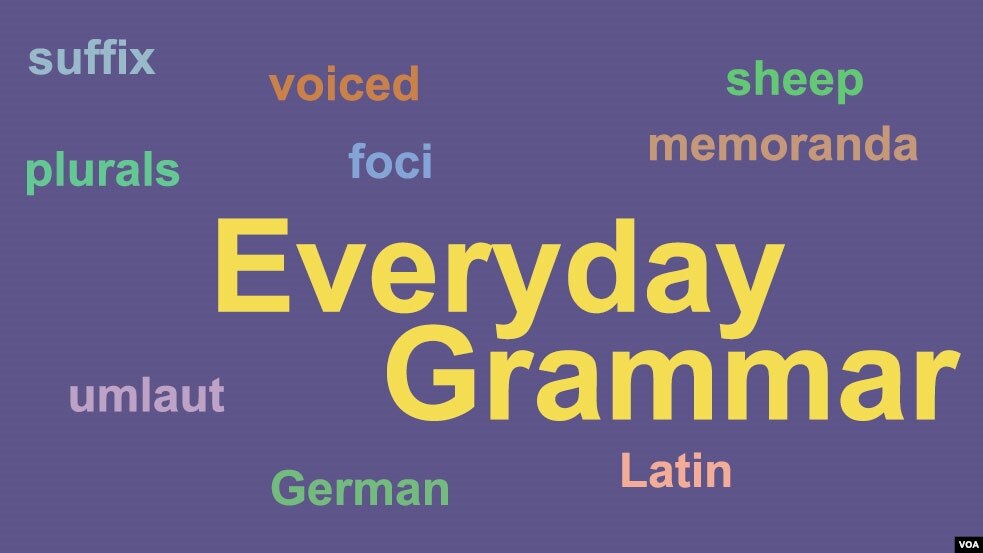
For VOA Learning English, this is Everyday Grammar.
One fish, two fish, red fish, blue fish, goes the Dr. Seuss children’s story. Why isn’t it two fishes? You may think, “Ok, it’s hard to count fish so we group them all together. No problem.”
Life on the farm
It’s easy to understand that farmers would not worry about making plurals when they talk about sheep. After all, they are almost always in a group. When you have one sheep, you can also call it a ram or a ewe, and make those nouns plural by adding an –s: rams and ewes.
Let’s look at some other things we can make plural. You’ve got a left foot and a right foot. Put them together and what have you got? Two feet. That doesn’t follow the “add an –s” rule.
Same with mouse and its plural, mice. What happened to our neat rule for making words plural?
The German influence
The answer is in our history. English came from German roots. German grammar changes the vowel sound in the middle of the word to show it is plural. The plural form of the German word for goose, Gans is Gänse. The vowel with two dots over it is called an umlaut. So goose becomes geese in English.
There are other plurals where the vowel changes like in the German pattern. Man – men and woman – women are examples of different vowel sounds in plural words. Sometimes a consonant changes, as with words that end in an f sound, such as leaf. The voiceless sound f takes on a voiced quality, or v, and an s sound is added to the word. We have autumn leaves and sharp knives.
Another way to make plurals in English is to add the suffix –en. We see this in the words brother – brethren; child - children and ox - oxen. These are words that come from Old English.
Words of foreign origin
With words that come from foreign languages, there are some patterns that may help you remember the plural. Many technical words in English came from Latin. Let’s look at the plural of some words from Latin. Words that end in –us drop that ending and add –i to become plural, as in fungus – fungi and cactus – cacti.
What is that orange thing on the tree?
It’s a fungus. There are a lot of different fungi in this forest.
For words that end in –um, the ending changes to –a, as in the words datum – data and medium – media. These two words are more common in their plural forms than the singular forms in our digital life. Listen to how the words medium and media appear in this conversation.
I heard you got a job at the New York Times.
Yeah, I’m glad to be working in mass media.
But newspapers are a dying medium, aren’t they?
Hey, I hope not. I’m writing a blog for them.
When a word from Latin ends in –ex or –ix, the plural ending is –ices. This results in index – indices and matrix – matrices. Here is another conversation
The financial news is bad. The Dow Jones index is down.
Don’t worry, there are other indices, like employment, going up.
Try it yourself
Are you ready to try making plurals with some English words?
Use the Germanic pattern for these words:
tooth (plural: teeth)
wolf (plural: wolves)
Use the Latin pattern for these words:
mémorandum (plural: memoranda)
focus (plural: foci)
There are many more irregular plural forms in English. We’ll look at those in another episode of Everyday Grammar. For now, we leave you with Frank Sinatra, singing Autumn Leaves,
But I miss you most of all my darling
When autumn leaves start to fall
Now it’s your turn. Write a sentence with an unusual plural and we'll give you feedback in the comments section.
Dr. Jill Robbins wrote this story for Learning English. Kathleeen Struck was the editor.
Words in This Story
ram – n. an adult male sheep
ewe – n. a female sheep
umlaut – n. a mark ¨ placed over a vowel (such as a u in German) to indicate a specific pronunciation
voiceless – adj. technical, of a sound made without moving your vocal cords
voiced – adj. technical, of a sound made by moving your vocal cords
suffix – n. a letter or a group of letters that is added to the end of a word to change its meaning or to form a different word
Reference

